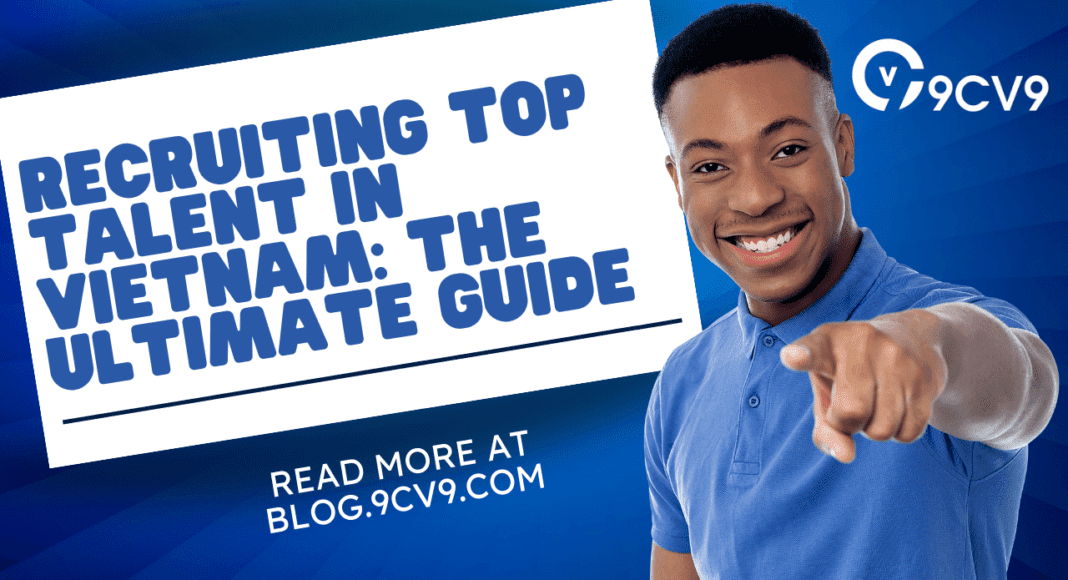Key Takeaways
- Understand the Vietnamese job market: Gain insights into the cultural nuances, preferences, and dynamics that shape the Vietnamese job market to tailor your recruitment strategies effectively.
- Develop an effective recruitment strategy: Utilize a mix of online job portals, social media platforms, local networks, and partnerships with universities to attract top talent in Vietnam.
- Foster retention through onboarding and engagement: Create a comprehensive onboarding program, foster a positive work environment, provide growth opportunities, and promote diversity and inclusion to retain and engage the best talent in Vietnam.
Welcome to our comprehensive guide on recruiting top talent in Vietnam.
As the Vietnamese job market continues to thrive, finding and attracting top talent has become increasingly crucial for organizations looking to succeed in this dynamic and competitive landscape.
Whether you are an HR professional, a recruiter, or a business owner, this ultimate guide will equip you with the knowledge and strategies needed to build a high-performing team in Vietnam.
A. Understanding the Importance of Recruiting Top Talent in Vietnam
In today’s fast-paced business environment, organizations recognize that their success hinges on the caliber of their workforce.
Top talent brings fresh perspectives, innovative ideas, and the skills necessary to drive growth and overcome challenges.
In Vietnam, where the job market is highly competitive, recruiting and retaining top talent is essential for gaining a competitive edge and achieving long-term success.
B. The Landscape of the Vietnamese Job Market
To effectively recruit top talent in Vietnam, it is crucial to have a comprehensive understanding of the job market landscape.
Vietnam’s economy has experienced rapid growth, driven by factors such as foreign investment, industrialization, and a burgeoning entrepreneurial culture.
This growth has led to increased demand for skilled professionals across various industries, including technology, manufacturing, finance, and services.
C. Unique Characteristics of the Vietnamese Talent Pool
Recruiting in Vietnam comes with its own set of unique considerations.
Understanding the characteristics of the Vietnamese talent pool is key to tailoring your recruitment strategies.
Vietnam boasts a young and dynamic workforce, with a large portion of the population falling within the millennial and Gen Z age groups.
These digital natives bring technological fluency, adaptability, and a hunger for career growth.
D. Cultural and Language Factors in Talent Acquisition
Vietnamese culture and language play significant roles in talent acquisition.
Building relationships and establishing trust are crucial in the Vietnamese business context.
Understanding and respecting Vietnamese cultural norms and values, such as hierarchical structures and the importance of personal connections, can greatly enhance your recruitment efforts.
Additionally, while English proficiency is increasing, incorporating Vietnamese language skills into your recruitment process can be advantageous.
E. Tapping into the Vietnamese Education System
Education plays a vital role in the talent pipeline of any country, and Vietnam is no exception.
The Vietnamese education system has undergone significant improvements, producing a pool of highly skilled graduates.
Collaborating with universities, vocational schools, and training institutions can provide access to top-tier talent and foster long-term partnerships.
F. Navigating Legal and Regulatory Considerations
Recruiting top talent in Vietnam involves adhering to local labor laws and regulations.
Familiarizing yourself with the legal framework, work permits, visa requirements, and employment contracts is essential to ensure compliance and avoid potential legal pitfalls.
Consulting with legal experts or local HR professionals can provide invaluable guidance in this area.
G. Crafting an Effective Employer Brand
In a competitive job market, having a strong employer brand is crucial for attracting top talent.
Building an employer brand that resonates with the Vietnamese workforce requires a clear understanding of their aspirations, values, and expectations.
Communicating your organization’s mission, culture, employee benefits, and career development opportunities will help you stand out and attract the best candidates.
H. Tailoring Recruitment Strategies for Vietnam
Recruiting top talent in Vietnam requires a tailored approach.
This guide will delve into various recruitment strategies, including leveraging online job portals, social media platforms, recruitment agencies, and employee referral programs.
We will explore the best practices for writing compelling job descriptions, conducting effective interviews, and assessing candidates to ensure cultural fit and alignment with your organization’s goals.
I. Onboarding and Retention of Top Talent
Successfully recruiting top talent is only the first step.
To build a high-performing team, you must also focus on onboarding and retention.
We will discuss strategies for creating comprehensive onboarding programs, providing mentorship and support, fostering a positive work environment, and offering competitive compensation and benefits packages.
J. Embracing Remote Work and Digital Talent Acquisition The COVID-19 pandemic has accelerated the adoption of remote work and digital recruitment practices. We will explore the opportunities and challenges of remote work in Vietnam, as well as the technologies and tools that can facilitate virtual recruitment and collaboration.
In this ultimate guide, we will equip you with the knowledge, insights, and actionable strategies needed to recruit top talent in Vietnam successfully. Whether you are an organization looking to expand your team or a professional seeking career opportunities in Vietnam, this guide will be your go-to resource for navigating the intricacies of the Vietnamese job market. Get ready to unlock the full potential of talent acquisition in Vietnam.
Recruiting Top Talent in Vietnam: The Ultimate Guide
- Understanding the Vietnamese Job Market
- Identifying Your Talent Needs
- Developing an Effective Recruitment Strategy
- Attracting Top Talent in Vietnam
- Screening and Interviewing Candidates
- Onboarding and Retaining Top Talent
1. Understanding the Vietnamese Job Market

The Vietnamese job market is a dynamic and evolving landscape that presents both opportunities and challenges for organizations seeking to recruit and retain top talent. To effectively navigate this market, it is crucial to have a comprehensive understanding of its unique characteristics, trends, and factors that influence talent acquisition. In this section, we will delve deep into the intricacies of the Vietnamese job market, equipping you with valuable insights and actionable knowledge.
- Economic Growth and Industry Trends: Vietnam has experienced remarkable economic growth in recent years, positioning itself as one of the fastest-growing economies in Southeast Asia. Key drivers of this growth include foreign direct investment, industrialization, and a thriving entrepreneurial ecosystem. As a result, various industries have witnessed significant expansion, leading to increased demand for skilled professionals.
For example, the technology sector in Vietnam has experienced exponential growth, attracting both local startups and multinational corporations. The emergence of tech hubs like Ho Chi Minh City and Hanoi has created a vibrant ecosystem that fosters innovation and entrepreneurship. Consequently, there is a high demand for tech talent, including software developers, data scientists, and digital marketing specialists.
- Demographics and Population Dynamics: Vietnam has a young and rapidly growing population, with a median age of around 31.6 years. The country’s youthfulness presents a unique advantage, as younger generations bring energy, adaptability, and a fresh perspective to the workforce. Additionally, the growing middle class and rising disposable incomes have contributed to increased consumer spending, fueling demand in sectors such as retail, hospitality, and services.
For instance, the tourism industry in Vietnam has experienced substantial growth, with a significant influx of international tourists. This has created a demand for hospitality professionals, tour guides, and customer service representatives who can cater to the needs of both domestic and international travelers.
- Education and Skills Landscape: The Vietnamese education system has undergone significant improvements, producing a pool of highly skilled graduates. Universities, vocational schools, and training institutions play a crucial role in nurturing talent and equipping students with the necessary knowledge and skills.
Vietnam has a strong focus on science, technology, engineering, and mathematics (STEM) education. As a result, there is a steady supply of engineering graduates, IT specialists, and other STEM-related professionals. Additionally, vocational schools provide training in fields such as automotive technology, hospitality, and construction, catering to the needs of specific industries.
For example, Vietnam has emerged as a manufacturing hub, attracting investments from multinational companies. The availability of skilled workers in areas like electronics, automotive manufacturing, and textiles has been instrumental in driving the country’s manufacturing sector.
- Cultural and Language Factors: Vietnamese culture plays a significant role in the job market and recruitment practices. Building relationships and establishing trust are highly valued in Vietnamese business culture. Personal connections and recommendations from trusted sources often carry more weight than traditional qualifications alone.
Understanding and respecting Vietnamese cultural norms can greatly enhance your recruitment efforts. For instance, addressing candidates by their proper titles and showing respect for hierarchy during interviews and interactions can leave a positive impression. Additionally, demonstrating an understanding of local customs and traditions can help build rapport with candidates.
Moreover, while English proficiency is increasing among the younger generation, incorporating Vietnamese language skills into your recruitment process can be advantageous. It enables better communication and demonstrates a commitment to understanding the local culture and market.
- Government Policies and Regulations: Navigating the legal and regulatory landscape is essential when recruiting in Vietnam. The government has implemented various labor laws and regulations to protect workers’ rights and ensure fair employment practices.
For instance, employers must comply with minimum wage requirements, social insurance contributions, and working hour limits. Understanding these regulations and incorporating them into your recruitment and employment practices is crucial to avoid legal issues and maintain compliance.
Understanding the Vietnamese job market requires a holistic view of its economic growth, industry trends, demographics, education system, cultural nuances, and regulatory framework.
By gaining insights into these aspects, organizations can tailor their recruitment strategies to attract and retain top talent effectively.
2. Identifying Your Talent Needs

Before embarking on the recruitment journey in Vietnam, it is essential to have a clear understanding of your organization’s talent needs.
Identifying the specific roles, skills, and qualities you are seeking will enable you to streamline your recruitment efforts and attract the right candidates.
In this section, we will explore the key steps to effectively identify your talent needs and provide relevant examples to illustrate the process.
- Assessing Your Organization’s Objectives and Growth Plans: Start by aligning your talent acquisition strategy with your organization’s goals and objectives. Consider the short-term and long-term plans, expansion initiatives, and areas where additional talent is required to support growth. This assessment will help you identify the specific positions and skills needed to drive your organization forward.
For example, if your organization plans to expand its operations into new regions or markets, you may require professionals with expertise in market research, business development, or international relations to support these expansion efforts.
- Conducting a Job Analysis: A thorough job analysis involves deconstructing each role within your organization to identify the key responsibilities, required skills, qualifications, and competencies. This analysis provides a comprehensive overview of the talent requirements for each position, enabling you to create targeted job descriptions and effectively communicate your expectations to potential candidates.
For instance, if you are seeking a software engineer, a job analysis may reveal that the role requires proficiency in programming languages such as Python or Java, experience with web development frameworks, and strong problem-solving skills.
- Evaluating the Existing Workforce: Assessing your current workforce can provide valuable insights into the skills and gaps that need to be addressed through recruitment. Identify the strengths and weaknesses of your current team and determine where additional talent is required to fill the skill gaps or complement the existing skill sets.
For example, if your organization lacks expertise in digital marketing, you may need to recruit a digital marketing specialist to strengthen your marketing team’s capabilities.
- Considering Future Skills and Industry Trends: Anticipate future skill requirements by considering industry trends, emerging technologies, and evolving job roles. Stay abreast of advancements in your industry and identify the skills that will be in high demand in the coming years. This proactive approach ensures that you are not only addressing your current talent needs but also preparing for the future.
For instance, if you operate in the finance industry, you might anticipate an increasing need for professionals with expertise in financial technology (fintech), data analytics, or cybersecurity. By identifying these future skill needs, you can start sourcing and developing talent in these areas ahead of time.
- Collaborating with Hiring Managers and Department Heads: Engage in open communication with hiring managers and department heads to gain their insights and perspectives on talent needs within their respective teams. Their expertise and understanding of the specific requirements for each role can help refine your talent acquisition strategy and ensure alignment with the operational needs of the organization.
For example, if the sales department highlights the need for candidates with experience in selling enterprise software solutions, you can prioritize this requirement in your recruitment efforts.
- Analyzing Competitor and Industry Benchmarks: Conduct benchmarking exercises to understand how your organization’s talent needs compare to industry standards and competitors. Analyzing the talent profiles and skill sets of successful companies within your industry can provide valuable insights into the desired qualifications and qualities sought after by top performers.
For example, if you are a technology company aiming to recruit top software engineers, researching the talent requirements of industry leaders in the tech sector can give you a benchmark for the skills and experience you should be targeting.
By following these steps and tailoring them to your organization’s unique needs, you can effectively identify the talent requirements necessary to drive your organization’s success in the Vietnamese job market.
This targeted approach ensures that your recruitment efforts are focused on attracting candidates who possess the specific skills and qualities needed to thrive within your organization.
Also, read “The Future of Hiring in Vietnam: Trends and Predictions in 2024” to learn about hiring trends for the next few years in Vietnam.
3. Developing an Effective Recruitment Strategy

A well-crafted recruitment strategy is vital for attracting and selecting the best talent in the Vietnamese job market.
With a clear plan in place, you can streamline your recruitment efforts, optimize your resources, and improve your chances of finding the right candidates.
In this section, we will explore the key steps to develop an effective recruitment strategy in Vietnam, along with relevant examples to illustrate each stage.
- Define Your Employer Brand: Your employer brand is the perception of your organization as an employer. It encompasses your mission, values, culture, and reputation in the job market. Clearly defining and articulating your employer brand is crucial for attracting top talent who align with your organization’s values and aspirations.
For example, if your organization promotes a culture of innovation and collaboration, emphasize these values in your employer branding efforts. Showcase success stories, employee testimonials, and initiatives that demonstrate your commitment to fostering a positive and engaging work environment.
Also, read our top guide on “5 Essential Strategies for Building a Strong Employer Brand” to learn more in-depth on how to build the best Employer Branding.
- Craft Compelling Job Descriptions: Job descriptions are the first point of contact between your organization and potential candidates. A well-written job description communicates the responsibilities, qualifications, and expectations for the role, attracting candidates who possess the required skills and experience.
Ensure that your job descriptions are concise, yet detailed enough to provide a clear understanding of the position. Incorporate relevant keywords that candidates are likely to search for when looking for job opportunities in your industry. This will improve the visibility of your job postings in online searches.
For example, if you are hiring a marketing manager, your job description could include keywords such as “digital marketing,” “social media management,” and “marketing strategy” to attract candidates with expertise in these areas.
Also, read on our top guide “Mastering the Art of Writing Effective Job Descriptions: A Comprehensive Guide” to learn about crafting the best Job Descriptions in the world.
- Utilize Online Job Portals and Platforms: Online job portals such as 9cv9 Job Portal and platforms have become integral to the recruitment process in Vietnam. Leveraging these platforms allows you to reach a wide audience of job seekers actively seeking opportunities. Choose reputable job portals that cater to your industry or target audience to maximize your reach and increase the likelihood of finding qualified candidates.
For instance, popular job portals in Vietnam include 9cv9 and LinkedIn. These platforms offer advanced search filters, resume databases, and candidate screening tools to help you identify potential candidates efficiently.
That’s why we researched and wrote on the best top job portals in Vietnam for hiring managers to try and kickstart their hiring. Read more here “Top Free Job Posting Sites in Vietnam to Hire Employees” to find out more.
- Leverage Social Media: Social media platforms provide an excellent opportunity to engage with candidates and promote your employer brand. Create a presence on platforms like LinkedIn, Facebook, and Instagram to showcase your organization’s culture, values, and job openings.
Share engaging content that highlights your company’s achievements, employee testimonials, and community involvement. Engage with job seekers by responding to comments, inquiries, and direct messages promptly.
For example, you can share photos or videos of team-building activities, employee spotlights, or testimonials to give candidates a glimpse into your organization’s work environment and culture.
- Employee Referral Programs: Employee referrals can be a valuable source of high-quality candidates. Implement an employee referral program that incentivizes your current employees to refer qualified individuals for open positions.
Offer rewards such as cash bonuses, additional vacation days, or recognition programs for successful referrals. Communicate the program effectively to employees, emphasizing the benefits and encouraging them to actively participate in the referral process.
For instance, you could announce the referral program in company-wide meetings, send regular email reminders, or create a dedicated internal communication channel where employees can submit referrals.
- Collaborate with Recruitment Agencies: Recruitment agencies such as 9cv9 Recruitment Agencies can be valuable partners in the talent acquisition process. They have access to a broad network of candidates, industry expertise, and experience in conducting candidate assessments.
Collaborating with reputable recruitment agencies that specialize in your industry or target positions can save you time and effort in sourcing and screening candidates. Clearly communicate your requirements and expectations to the agency to ensure they understand your organization’s needs.
For example, if you are recruiting for executive-level positions, partnering with an executive search firm with a strong track record in your industry can help you identify and attract top-tier candidates.
Also read, “Top 10 Recruitment Agencies in Vietnam For Employers to Use” to learn on the best and top recruitment agencies in Vietnam to start hiring the rare and top talents.
- Implement a Structured Interview Process: Develop a structured interview process to ensure consistency and fairness when evaluating candidates. Define a set of standardized interview questions that assess the key competencies and qualifications required for the role.
Consider using a combination of behavioral-based questions, situational questions, and technical assessments to evaluate candidates thoroughly. Train your hiring managers and interview panel on the interview process and ensure they understand the desired qualities and skills for each position.
For instance, if you are hiring for a customer service role, your structured interview process could include questions that assess communication skills, problem-solving abilities, and customer-centric mindset.
Also, read the “Top 5 Interview Formats You Need to Know About” to learn how to create and structure interviews properly.
- Build Talent Pools: Maintain a talent pool or talent database consisting of potential candidates who may be a good fit for your organization in the future. Engage with these candidates regularly, even if there are no immediate job openings.
Nurture relationships through periodic communication, such as sharing industry news, professional development opportunities, or company updates. When a relevant position becomes available, you can reach out to these candidates who have already shown interest in your organization.
For example, you can use a customer relationship management (CRM) tool or applicant tracking system (ATS) to organize and manage your talent pool effectively.
By following these steps and tailoring them to your organization’s specific needs, you can develop an effective recruitment strategy that attracts top talent in the Vietnamese job market.
Continuously evaluate and refine your strategies based on feedback, performance metrics, and changing market dynamics to stay competitive in attracting and selecting the best candidates for your organization.
4. Attracting Top Talent in Vietnam

In a competitive job market like Vietnam, attracting top talent requires a strategic and targeted approach.
Organizations must showcase their unique value proposition, cultivate a positive employer brand, and implement effective recruitment tactics.
In this section, we will explore key strategies for attracting top talent in Vietnam, along with relevant examples to illustrate each approach.
- Build a Strong Employer Brand: A compelling employer brand is essential for attracting top talent. It represents your organization’s reputation, values, culture, and overall appeal as an employer. By showcasing what makes your company unique, you can differentiate yourself from competitors and attract the attention of highly skilled candidates.
For example, if your organization has a strong commitment to corporate social responsibility, emphasize your sustainability initiatives, community involvement, and employee volunteer programs. Highlighting these aspects of your employer brand can resonate with candidates who share similar values.
Also, read our top guide on “5 Essential Strategies for Building a Strong Employer Brand” to learn more in-depth on how to build the best Employer Branding.
- Develop an Engaging Company Culture: A positive and engaging company culture is a powerful magnet for top talent. Create an environment that promotes collaboration, innovation, and employee growth. Encourage open communication, provide opportunities for professional development, and foster a healthy work-life balance.
For instance, you can offer flexible work arrangements, provide employee wellness programs, or establish mentorship programs to support career progression. These initiatives demonstrate your commitment to creating a supportive and fulfilling work environment.
- Offer Competitive Compensation and Benefits: Competitive compensation and benefits play a significant role in attracting top talent. Conduct market research to ensure your salary packages are competitive within your industry and aligned with the skills and experience required for the position.
Consider offering additional perks and benefits that go beyond salary, such as health insurance, retirement plans, paid time off, and professional development opportunities. These incentives can be powerful motivators for candidates to choose your organization over competitors.
- Embrace Workplace Diversity and Inclusion: Promoting diversity and inclusion in the workplace can help attract top talent from diverse backgrounds. Create a culture that values and respects individuals from all walks of life. Emphasize your commitment to fostering an inclusive environment where employees feel valued and have equal opportunities for growth.
For example, you can showcase diversity initiatives, employee resource groups, and partnerships with organizations that promote diversity and inclusion. This demonstrates your organization’s commitment to creating a diverse and equitable workplace.
- Leverage Employee Testimonials and Success Stories: Utilize the power of employee testimonials and success stories to showcase the positive experiences of your current employees. Encourage employees to share their stories, career progression, and the impact your organization has had on their professional development.
Highlight these testimonials on your website, social media platforms, and recruitment materials. Prospective candidates are more likely to be attracted to an organization when they see real-life examples of employees who have thrived within your company.
- Engage in Meaningful Corporate Social Responsibility: Demonstrate your organization’s commitment to social responsibility by engaging in meaningful initiatives. Support causes that align with your company’s values and resonate with potential candidates. Participate in community projects, volunteer programs, or environmental sustainability efforts.
For instance, if your organization operates in the technology sector, you can sponsor coding boot camps for underprivileged youth or collaborate with educational institutions to provide scholarships for STEM students. These initiatives not only make a positive impact but also attract socially conscious candidates.
- Optimize Your Online Presence: In today’s digital age, optimizing your online presence is crucial for attracting top talent. Ensure your company website is user-friendly, mobile-responsive, and showcases your employer brand effectively. Optimize your career page and job postings with relevant keywords to improve visibility in online searches.
Additionally, leverage social media platforms like LinkedIn, Facebook, and Instagram to engage with potential candidates. Regularly post relevant content, job openings, and updates about your organization. Engage with job seekers by responding to inquiries, comments, and messages promptly.
- Participate in Industry Events and Job Fairs: Industry events and job fairs provide opportunities to connect directly with job seekers and showcase your organization. Participate in relevant conferences, seminars, and job fairs to network with potential candidates.
For example, if you are a software development company, participate in tech conferences or host coding workshops to interact with aspiring developers. This direct interaction allows you to build relationships and create a positive impression among job seekers.
- Provide Clear Career Growth Opportunities: Top talent is often attracted to organizations that offer clear career growth paths. Clearly communicate the opportunities for advancement, professional development, and upward mobility within your organization.
Develop a comprehensive career development program that includes training, mentorship, and opportunities to take on challenging projects. Demonstrate how employees can progress within your organization and achieve their career goals.
For example, you can implement a performance management system that includes regular performance evaluations, goal-setting processes, and individual development plans. This showcases your commitment to employee growth and development.
- Implement Employee Referral Programs: Employee referral programs can be an effective way to attract top talent. Encourage your employees to refer qualified candidates by offering incentives such as cash bonuses, additional vacation days, or recognition programs.
Communicate the referral program effectively to employees, highlighting the benefits and actively seeking their participation. This taps into their networks and connections, increasing the chances of attracting talented individuals.
By implementing these strategies and adapting them to your organization’s unique needs, you can attract top talent in the Vietnamese job market. Continuously monitor and evaluate the effectiveness of your recruitment efforts, making adjustments as necessary to remain competitive in the quest for the best candidates.
Also, read “5 Essential Remote Work Tips for Boosting Your Productivity” to learn how to boost your employee’s productivity at work.
5. Screening and Interviewing Candidates

The screening and interviewing process is a critical step in finding the right candidates for your organization in Vietnam.
By implementing effective screening techniques and conducting thorough interviews, you can assess candidates’ qualifications, skills, and cultural fit.
In this section, we will explore key strategies for screening and interviewing candidates in Vietnam, along with relevant examples to illustrate each approach.
- Review Resumes and Cover Letters: The first step in screening candidates is to review their resumes and cover letters. Look for relevant experience, skills, and qualifications that align with the requirements of the position.
Pay attention to details such as job titles, dates of employment, and accomplishments. Look for consistency and clarity in the candidate’s career progression. Identify any gaps or red flags that may require further clarification during the interview process.
For example, if you are hiring a software developer, review the candidate’s technical skills, programming languages proficiency, and previous experience in relevant projects.
- Conduct Phone or Video Interviews: Phone or video interviews are an effective way to pre-screen candidates before inviting them for in-person interviews. These initial conversations allow you to assess candidates’ communication skills, enthusiasm, and overall fit for the role.
Prepare a set of standardized questions to ask each candidate during these interviews. Focus on evaluating their relevant experience, problem-solving abilities, and cultural fit within your organization.
For instance, if you are hiring a sales representative, you can ask questions about their sales achievements, their approach to building client relationships, and how they handle objections.
- Implement Skills Assessments and Tests: Skills assessments and tests provide objective measures to evaluate candidates’ abilities and proficiency in specific areas. Depending on the nature of the role, you can administer technical tests, problem-solving exercises, or cognitive assessments.
For example, if you are hiring for a graphic designer position, you can ask candidates to submit a portfolio of their previous design work or request them to complete a design task to assess their creative and technical skills.
- Conduct Structured Behavioral Interviews: Behavioral interviews are designed to assess candidates’ past behaviors and how they may perform in specific job-related situations. Develop a set of behavioral-based questions that focus on the core competencies and qualities required for the position.
For example, if you are hiring a project manager, you can ask candidates to provide examples of how they have handled tight deadlines, managed conflicting priorities, or resolved team conflicts.
- Evaluate Cultural Fit: Cultural fit is crucial for long-term success and employee satisfaction. Assessing candidates’ alignment with your organization’s values, work environment, and team dynamics is essential.
During the interview process, ask questions that delve into their preferred work styles, values, and how they handle collaboration and feedback. Look for candidates who demonstrate adaptability, teamwork, and a positive attitude.
For instance, if your organization emphasizes innovation and a fast-paced work environment, ask candidates how they have contributed to driving innovation or how they handle change.
- Involve Multiple Interviewers: Involving multiple interviewers in the process can provide diverse perspectives and help mitigate biases. Coordinate interviews with team members, managers, and stakeholders who will work closely with the selected candidate.
Assign specific areas of evaluation to each interviewer based on their expertise and the requirements of the position. This collaborative approach ensures a comprehensive assessment of each candidate.
For example, if you are hiring a marketing manager, involve the sales team to assess their ability to collaborate cross-functionally, and include a senior marketing professional to evaluate their strategic thinking.
- Provide a Realistic Job Preview: Offering candidates a realistic job preview helps manage expectations and ensures a better fit between the candidate and the role. Provide a clear picture of the responsibilities, challenges, and opportunities associated with the position.
This can be done through job shadowing, providing access to relevant materials, or arranging a meeting with a potential team member. By offering a realistic preview, you can attract candidates who are genuinely interested in the role and reduce the likelihood of early turnover.
- Check References and Conduct Background Checks: Before making a final hiring decision, conduct reference checks to verify the candidate’s qualifications, experience, and work ethic. Reach out to previous employers, supervisors, or colleagues to gain insights into the candidate’s performance, reliability, and character.
Additionally, conduct background checks to ensure the accuracy of the information provided by the candidate. This can include verifying education credentials, employment history, and conducting criminal record checks if necessary.
By implementing these strategies for screening and interviewing candidates, you can identify the most qualified individuals who align with your organization’s needs and culture.
Remember to document your assessments and evaluations for future reference and maintain a fair and consistent process for all candidates.
For more reading materials on interviews, read below for more information:
- Tips and Techniques to Ace Your Phone Interview
- Top 5 Interview Formats You Need to Know About
- 10 Tips and Tools on How to Prepare for a Job Interview
6. Onboarding and Retaining Top Talent

Onboarding and retaining top talent is crucial for the long-term success of your organization in Vietnam.
A well-structured onboarding process ensures that new employees feel welcome, supported, and equipped to make a positive impact from day one.
Additionally, effective retention strategies help keep talented individuals engaged, motivated, and committed to your organization.
In this section, we will explore key strategies for onboarding and retaining top talent in Vietnam, along with relevant examples to illustrate each approach.
- Develop a Comprehensive Onboarding Program: A comprehensive onboarding program sets the foundation for a successful employee experience. It helps new hires understand your organization’s culture, values, and expectations while providing the necessary resources and support to excel in their roles.
Consider incorporating the following elements into your onboarding program:
- Orientation: Provide an overview of the organization’s history, mission, vision, and key stakeholders. Introduce new hires to their team members, managers, and other relevant colleagues.
- Job Training: Offer job-specific training to ensure new employees have the knowledge and skills required to perform their roles effectively. This can include technical training, software familiarization, and mentorship programs.
- Company Policies and Procedures: Familiarize new hires with important policies, procedures, and compliance requirements. Cover topics such as code of conduct, ethics, confidentiality, and safety guidelines.
- Buddy System: Assign a mentor or buddy to new employees who can provide guidance, support, and answer questions during their initial period. This helps foster a sense of belonging and accelerates the integration process.
For example, if you are hiring a software engineer, you can provide technical training on your organization’s development tools and methodologies, assign them a mentor from the development team, and ensure they have a clear understanding of your software development lifecycle.
- Foster a Positive Work Environment: Creating a positive work environment is essential for retaining top talent. Employees who feel valued, respected, and supported are more likely to remain committed to your organization. Focus on the following aspects to foster a positive work environment:
- Communication: Encourage open and transparent communication at all levels. Provide opportunities for employees to share their ideas, concerns, and feedback. Regularly communicate company updates, goals, and achievements to keep employees informed and engaged.
- Recognition and Rewards: Implement a recognition and rewards program to acknowledge and appreciate employees’ contributions. This can include verbal recognition, performance-based bonuses, employee of the month awards, or career advancement opportunities.
- Work-Life Balance: Promote work-life balance by offering flexible work arrangements, telecommuting options, or wellness programs. Encourage employees to prioritize their well-being and provide resources to support their physical and mental health.
- Employee Engagement: Foster a sense of engagement by involving employees in decision-making processes, providing opportunities for skill development, and promoting a culture of continuous learning and growth.
For instance, you can organize regular team-building activities, offer professional development workshops, or establish employee resource groups to promote diversity and inclusion.
- Provide Opportunities for Growth and Development: Top talent is motivated by opportunities for growth and advancement. Provide clear career paths and development opportunities to retain and engage your employees. This can include:
- Training and Development Programs: Offer ongoing training programs to enhance employees’ skills and knowledge. This can be done through internal workshops, external courses, conferences, or mentorship programs.
- Performance Feedback and Coaching: Implement a structured performance management system that includes regular feedback sessions, goal-setting, and coaching. Provide constructive feedback to help employees improve their performance and identify areas for growth.
- Career Path Planning: Work with employees to create individual development plans that align with their career aspirations and organizational needs. Identify opportunities for advancement, job rotations, or specialized projects to broaden their experience.
For example, if you are a retail organization, you can offer training programs on customer service, merchandising, or sales techniques. Provide opportunities for employees to take on leadership roles within the organization, such as store manager or regional supervisor.
- Foster a Culture of Diversity and Inclusion: Diversity and inclusion are essential for attracting and retaining top talent. Embrace a culture that values and respects individuals from diverse backgrounds. Create a sense of belonging by:
- Emphasizing Diversity Initiatives: Communicate your organization’s commitment to diversity and inclusion through internal communications, recruitment materials, and company events. Highlight employee resource groups, diversity training programs, or community partnerships.
- Fair and Inclusive Practices: Ensure fair and inclusive practices throughout the organization, including recruitment, promotion, and performance evaluations. Train managers and employees on unconscious bias and create an inclusive culture where everyone’s voice is heard and valued.
- Mentorship and Sponsorship Programs: Establish mentorship or sponsorship programs to support the development and advancement of underrepresented groups within your organization. Pair employees with senior leaders who can provide guidance and advocate for their career growth.
For instance, you can participate in diversity-focused career fairs and conferences, engage with local community organizations that promote diversity and inclusion, or support initiatives that empower women in the workplace.
- Competitive Compensation and Benefits: Offering competitive compensation and benefits is crucial for attracting and retaining top talent. Regularly review your compensation packages to ensure they are in line with industry standards and consider:
- Salary and Performance-Based Incentives: Provide competitive salaries based on market research and the employee’s skills and experience. Consider implementing performance-based bonuses or incentives tied to individual or team achievements.
- Benefits and Perks: Offer a comprehensive benefits package that includes health insurance, retirement plans, paid time off, parental leave, and other perks that align with employee needs and expectations.
- Employee Wellness Programs: Support employee well-being by offering wellness programs, such as gym memberships, yoga classes, or mental health resources. These initiatives contribute to a positive work-life balance and employee satisfaction.
For example, you can conduct regular salary benchmarking surveys to ensure your salaries are competitive within the industry. Offer additional benefits like flexible working hours, remote work options, or a generous vacation policy to attract and retain top talent.
- Conduct Stay Interviews and Exit Interviews: Stay interviews are proactive conversations with employees to understand their job satisfaction, engagement level, and any potential challenges or concerns they may have. These interviews provide valuable feedback and insights that can inform retention strategies.
Similarly, exit interviews conducted when employees leave your organization can provide insights into areas for improvement and potential retention issues. Analyzing common themes from exit interviews can help identify patterns and implement necessary changes to enhance employee retention.
For example, you can conduct stay interviews annually or bi-annually with employees to understand their career goals, address any concerns they may have, and provide necessary support to ensure their satisfaction and retention.
By implementing these strategies for onboarding and retaining top talent, you can create a supportive and engaging environment that attracts and retains the best candidates in the Vietnamese job market.
Remember, ongoing evaluation and adaptation of these strategies based on employee feedback and industry trends are essential to ensure their effectiveness in the long run.
Conclusion
Recruiting top talent in Vietnam requires a strategic and tailored approach to navigate the unique characteristics of the Vietnamese job market.
By understanding the Vietnamese job market, identifying your talent needs, developing an effective recruitment strategy, attracting top talent, screening and interviewing candidates, and implementing onboarding and retention strategies, your organization can gain a competitive edge in attracting and retaining the best talent in Vietnam.
Understanding the Vietnamese job market involves recognizing the cultural values, preferences, and dynamics that shape the employment landscape.
Factors such as the importance of personal relationships, the significance of educational qualifications, and the influence of local networks play a crucial role in the recruitment process.
Adapting your recruitment strategies to align with these cultural nuances will help you attract and engage the top talent in Vietnam.
Identifying your talent needs is a crucial step in recruiting top talent.
Analyzing your organization’s current and future requirements enables you to define the skills, qualifications, and experience necessary for success in each role.
By understanding the specific talent gaps you need to fill, you can streamline your recruitment efforts and focus on attracting candidates who possess the desired competencies.
Developing an effective recruitment strategy involves leveraging a variety of channels and techniques to reach potential candidates.
Utilizing online job portals, social media platforms, and professional networks can significantly expand your talent pool.
Additionally, establishing partnerships with local universities, attending job fairs, and leveraging employee referrals can enhance your recruitment efforts.
By tailoring your approach to the Vietnamese job market, you can effectively position your organization as an employer of choice.
Attracting top talent in Vietnam requires showcasing your employer brand and highlighting the unique benefits and opportunities your organization offers.
Emphasize factors such as career growth prospects, work-life balance initiatives, and a positive work culture. Providing competitive compensation packages, professional development opportunities, and a supportive work environment can help you stand out in the job market and attract the best talent.
Screening and interviewing candidates are crucial steps to assess their qualifications, skills, and cultural fit.
By implementing effective screening techniques, such as resume reviews, phone or video interviews, skills assessments, and behavioral interviews, you can evaluate candidates’ suitability for the role.
Involving multiple interviewers and conducting reference checks further enhances the evaluation process.
Onboarding and retaining top talent are essential for long-term success.
By developing a comprehensive onboarding program, fostering a positive work environment, providing opportunities for growth and development, promoting diversity and inclusion, and offering competitive compensation and benefits, you can create an environment that attracts and retains the best talent.
Conducting stay interviews and exit interviews helps you understand employee satisfaction levels and identify areas for improvement.
Recruiting top talent in Vietnam requires a multi-faceted approach that considers the nuances of the Vietnamese job market and the specific needs of your organization.
By implementing the strategies outlined in this ultimate guide, you can position your organization as an employer of choice, attract top talent, and build a high-performing team that drives your organization’s success in Vietnam.
Remember, continuous evaluation, adaptation, and improvement are key to staying competitive in the dynamic job market and retaining the best talent over time.
If your company needs HR, hiring, or corporate services, you can use 9cv9 hiring and recruitment services. Book a consultation slot here, or send over an email to [email protected].
If you find this article useful, why not share it with your hiring manager and C-level suite friends and also leave a nice comment below?
We, at the 9cv9 Research Team, strive to bring the latest and most meaningful data, guides, and statistics to your doorstep.
To get access to top-quality guides, click over to 9cv9 Blog.
People Also Ask
How to hire in Vietnam?
Hiring in Vietnam? Discover the essential steps to successfully hire top talent in this dynamic market. From understanding the cultural nuances to navigating legal requirements, this guide will help you attract, screen, and onboard the best candidates in Vietnam. Don’t miss out on building a high-performing team.
What are some employment laws to take note of in Vietnam?
When hiring in Vietnam, be aware of key employment laws. Take note of regulations on minimum wage, working hours, employment contracts, social insurance, and labor disputes. Stay compliant with Vietnamese labor laws to ensure a fair and legal working environment for your employees.
What is the 13-month salary in Vietnam?
In Vietnam, the 13th-month salary is a mandatory bonus paid to employees, typically given before the Lunar New Year. It is equivalent to one month’s salary and serves as an additional reward for employees’ contributions throughout the year. Employers must adhere to the legal requirement of providing the 13th-month salary to eligible employees in Vietnam.































![Writing A Good CV [6 Tips To Improve Your CV] 6 Tips To Improve Your CV](https://blog.9cv9.com/wp-content/uploads/2020/06/2020-06-02-2-100x70.png)


